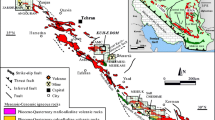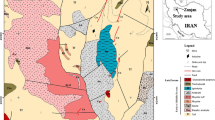Summary
Field relations, petrographic observations and fluid inclusion data are used to characterize the mineralizing fluids of gold-copper bearing quartz veins, which are spatially associated with a granite-porphyry, metavolcanics and metagabbro in the Hamash area, South Eastern Desert of Egypt. Four generations of genetically related quartz veins occur in the Hamash mine area. Two types of alteration are developed in vicinity of quartz veins; i.e., sericite-quartz-pyrite and chlorite-epidote-pyrite-sericite alteration. Fe-Cu sulfides in the veins were precipitated in two stages, early pyrite (PI) and chalcopyrite were altered to secondary chalcocite, bornite and digenite and a second generation of pyrite (PII and PIII). PI pyrite and quartz contain inclusions of gold as well as remobilized gold along cracks and microfractures. Two types of fluid inclusions are distinguished: 1) primary H2O-CO2-CH4-NaCl inclusions (type I) and 2) primary and secondary aqueous inclusions (type II). Type II is further subdivided by the inclusions occurrence within different vein types. Type I inclusions entrapped the endmembers of an unmixed fluid which consists of an aqueous phase and a CO2-rich gas phase, respectively. The entrapment conditions of approximately 250°C and 200 bars were estimated by intersecting the isochores of the two coexisting aqueous and CO2-rich fluids and indicate a shallow crustal level. The salinity of type IIa inclusions is generally low (< 9 wt.% NaCleq), they homogenize above 234°C and included heterogeneous and homogeneous fluids over a wide pressure range. Homogenization temperatures of type IIb inclusions vary between 102° and 284 °C, their assumed entrapping temperatures are 200°C and 110°C, respectively. The four generations of quartz veins are related with different inclusion types. The metals including primary gold were probably transported as bisulfide complexes and precipitated due to wallrock sulfidation, fluid mixing and phase separation. The Hamash Au-Cu mineralization shows a combination of porphyry- and epithermal-deposits characteristics.
Zusammenfassung
Geländebeziehungen, petrographische Beobachtungen und Untersuchungen an Flüussigkeitseinschlüssen erlauben die Charakterisierung der mineralisierenden Fluide in Gold-Kupfer-führenden Quarzgängen, die mit einem Porphyr-Granit und einem Gabbro im Hamash Gebiet der südöstlichen Wüste von Ägypten assozüert sind. Vier Generationen von Quarzgängen kommen im Gebiet der Hamash Mine vor. Zwei Alterationstypen sind in der Nähe der Quarzgänge ausgebildet: Serizit-Quarz-Pyrit und Chlorit-Epidot-Pyrit-Serizit Alteration. Die Fe-Cu-Sulfide in den Gängen wurden in zwei Etappen ausgefällt, früh kristallisierter Pyrit (PI) und Kupferkies wurden zu sekundärem Chalkosin, Bornit und Digenit sowie einer zweiten Generation von Pyrit (PII und PII) umgewandelt. PI Pyrit und Quarz enthalten sowohl Gold-Einschlüsse als auch remobilisiertes Gold entlang von Spalten und Mikrobrüchen. Zwei Typen von Flüssigkeitseinschlussen wurden unterschieden: 1) primäre H2O-CO2-CH4-NaCl Einschlusse (Typ 1), 2) primäre und selcundäre wäßrige Einschlusse (Typ II). Typ I Einschlusse schlossen die Endglieder eines entmischten Fluides ein, das aus einer wässrigen bzw. einer CO2-reichen Gasphase bestand. Die Einschlußedingungen von ungefähr 250°C und 200 bar wurden durch den Schnittpunkt der Isochoren der beiden koexistierenden Fluide bestimmt und zeigen einen seichten Krustenbereich an. Die Salinität von Typ Ila Einschlussen ist generell niedrig (<9 Gew.% NaCleq), sie homogenisieren uber 234 °C und schlossen heterogene und homogene Fluide über einen großen Druckbereich ein. Die Homogenisationstemperaturen von Typ IIb Einschlussen variieren zwischen 102° und 284°C, ihre angenommenen Einfangtemperaturen liegen bei 200 °C bzw 110 °C. Die vier Generationen von Quarzgängen stehen in Zusammenhang mit den verschiedenen Typen von Flussigkeitseinschlussen. Die Metalle, einschließlich des primaären Goldes, wurden wahrscheinlich als BisulphidKomplexe transportiert und auf Grund von Sulfidisierung der Nebengesteine, Fluidmischung und Phasenseparation ausgefällt. Die Hamash Au-Cu Mineralisation zeigt eine Kombination von Porphyr- und Epithermal-Lagerstätten Charakteristika.
Similar content being viewed by others
References
Amcoff O (1988) Experimental replacement of chalcopyrite by bornite: textural and chemical changes during solid-state process. Mineral Deposita 23: 286–292
Brown PE, Hagemann SG (1994) MacFlinCor: a computer program for fluid inclusion data reduction and manipulation. In:De Vivo B, Frezzotti ML (eds) Fluid inclusions in minerals: methods and applications. Virginia Tech, Pontignano - Siena, pp 231–250
Bugrov V (1972) Mineral potential of Aswan region. Geochemical operations July 1968–June 1972 UNDP Technical Report 3 New York 31–33, 63
Diamond LW (1994) Salinity of multivolatile fluid inclusions determined from clathrate hydrate stability. Geochim Cosmochim Acta 58: 19–41
Drummond SE, Ohmoto H (1985) Chemical evolution and mineral deposition in boiling hydrothermal systems. Econ Geol 80: 126–147
El Gaby S, El Aref M (1977) Geological, petrochemical and geochemical studies on the Shait granite at Wadi Shait, Eastern Desert, Egypt. Bull Fac Sci Assiut Univ 6: 307–329
El Gaby S, List FL, Teherani R (1988) Geology, evolution and metallogenesis of the Pan-African Belt in Egypt. In:El Gaby S, Greiling RO (eds) The Pan-African Belt of Northeast Africa and adjacent areas. Vieweg, Braunschweig, pp 17–68
El Mahallawi MM (1995) Rare earth element geochemistry and petrogenesis of the Shaitian granitoid rocks, Wadi Shait area, Eastern Desert, Egypt. El Minia Sci Bull 8: 78–96
Gammons CH, Bloom MS, Yu Y (1992) Experimental investigations of the hydrothermal geochemistry of platinum and palladium. 1. Solubility of platinum and palladium sulfide minerals in NaCl/H2SO4 solutions at 300°C. Geochim Cosmochim Acta 56: 3881–3894
Garson MS, Shalaby IM (1976) Precambrian-Lower Paleozoic plate tectonics and metallogenesis in the Red Sea region. Geol Assoc Can Spec Paper 14
Hassanen MA, El-Sayed MM (1997) Petrogenesis and tectonic environment of Hamash Dokhan volcanics, Southeastern Desert, Egypt. Egypt J Geol 41-1: 153–173
Henley RW (1991) Epithermal gold deposits in volcanic terranes. In:Foster RP (ed) Gold metallogeny and exploration. Blackie, Glasgow London, pp 13–164
Hilmy ME, Osman A (1989) Remobilization of gold from a chalcopyrite-pyrite mineralization Hamash gold mine, Southeastern Desert, Egypt. Mineral Deposita 24: 244–249
Hussein AA (1990) Mineral deposits of Egypt. In:Said R (ed) The geology of Egypt. Balkema, Rotterdam, pp 511–556
Huston DL, Sic SH, Suter GF, Cooke DR, Both RA (1995) Trace elements in sulfide minerals from Eastern Australian volcanic-hosted massive sulfide deposits, part I. Proton microprobe analyses of pyrite, chalcopyrite and sphalerite. Part II: Selenium levels in pyrite: comparison with 634S values and implications for the source of sulfür in volcanogenic hydrothermal systems. Econ Geol 90: 1167–1196
Hyland HM, Bancroft GM (1989) A XPS study of gold deposition at low temperatures on sulphide minerals reducing agents. Geochim Cosmochim Acta 53: 367–372
Kullerud G (1967) Sulfide studies. In:Abelson PH (ed) Researches in geochemistry, vol 2. J Wiley, New York, pp 286–323
MacDonald AJ, Spooner ETC (1981) Calibration of a Linkam TH 600 programmable heating-cooling stage for microthermometric examination of fluid inclusions. Econ Geol 76: 1248–1258
Moustafa GA, Hilmy ME (1958) Geology of the Hamash-Sufra District. Geol Surv Egypt Paper 12: 31
Osman A (1995) A comparative study on gold mineralization of Um Balad and Hamash areas, Eastern Desert, Egypt. MERC Ain Shams Univ Earth Sci Ser 9: 61–79
Phillips GN, Groves DI (1984) Fluid acces and fluid-wall rock interaction in the genesis of the Archean gold-quartz vein deposit at Hunt mine, Kambalda, Western Australia. In:Foster RP (ed) Gold'82: the geology, geochemistry and genesis of gold deposits. Balkema, Rotterdam, pp 389–416
Potter RW, Clynne MA, Brown DL (1978) Freezing point depression of aqueous sodium chloride solutions. Econ Geol 73: 284–285
Sawkins FJ (1984) Metal deposits in relation to plate tectonics. Springer, Berlin Heidelberg New York Tokyo, 325 pp
Schurmann HME (1953) The Precambrian of the Gulf of Suez area. Int Geol Congr Algeria, C.R. Sec 1, Fasc 1
Shenberger DM, Barnes HL (1989) Solubility of gold in aqueous sulfide solutions from 150° to 350°C. Geochim Cosmochim Acta 53: 269–278
Shepherd TJ, Rankin AH, Alderton DH (1985) A practical guide to fluid inclusion studies. Blackie, Glasgow, 239 pp
Sibson RH, Robert F, Poulsen KH (1988) High-angle reverse faults, fluid-pressure cycling and mesothermal gold-quartz deposits. Geol 16: 551–555
Stern RJ, Gottfried D, Hedge CE (1984) Late Precambrian rifting and crustal evolution in the Northeastern Desert of Egypt. Geol 12: 168–172
Takenouchi S, Kennedy C (1964) The binary system H2O-CO2 at high temperatures and pressures. Am J Sci 262: 1055–1074
Takla MA, El Dogdoug AA, Rasmy AH, Gad MA, El Tabbal H (1990) Origin of Um Eliega gold mineralization, Southeastern Desert, Egypt. J Mineral Soc Egypt 2: 3–20
Thiery R, van den Kerkhof A, Dubessy J (1994) VX properties of CH4-CO2 and CO,-N2 fluid inclusions: modelling for T < 31 °C and P < 400 bars. Eur J Mineral 6: 753–771
Zhang YG, Frantz JD (1987) Determination of homogenisation temperatures and densities of supercritical fluids in the systems NaCl-KCl-CaCl2-H2O. Chem Geol 64: 335–350
Zhang Y, Frantz JD (1992) Hydrothermal reactions involving equilibrium between minerals and mixed volatiles 2. Investigations of fluid properties in the CO2-CH4-H2O system using synthetic fluid inclusions. Chem Geol 100: 51–72
Author information
Authors and Affiliations
Additional information
With 6 Figures
Rights and permissions
About this article
Cite this article
Helmy, H.M., Kaindl, R. Mineralogy and fluid inclusion studies of the Au-Cu quartz veins in the Hamash area, South-Eastern Desert, Egypt. Mineralogy and Petrology 65, 69–86 (1999). https://doi.org/10.1007/BF01161577
Received:
Accepted:
Issue Date:
DOI: https://doi.org/10.1007/BF01161577




